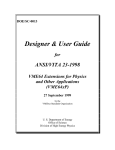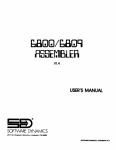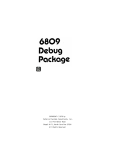Download Adobe pdf formats
Transcript
A VMEbus Adapter for G-64 by J.Niewold(1), L.Arnaudon(2), C.Parkman(1) and M.Saich(1) CERN 1211 Geneva 23 Switzerland (1) ECP Division, (2) SL Division ABSTRACT The limited address space of the G-64 bus poses problems in an increasing number of applications, particularly for the use of the modern, high-level communications protocols. Whilst the replacement of G-64 by single height VMEbus systems would provide a longterm answer to its technical limitations, an adapter permitting a limited number of singleheight VMEbus modules to be inserted into an existing G-64 system supplies an interim solution. This paper describes such an adapter, which provides up to three VMEbus “slots” for the G-64 crates in the Aleph experiment’s control system at CERN, together with a brief description of the OS-9 software environment. carrying 96-pin connectors on the rear of each of the extreme slots. One spacer carries all the necessary logic, implemented The provision of modern communications in systems based using surface-mounted components to save space, the other on the G-64 [1] backplane bus has proved to be difficult, (an identical, but unmounted, printed circuit) carries only owing in part to its restricted address space. Whilst its total power connections. replacement by single height (“3U”) VMEbus [2] could provide a radical long-term solution to the deficiencies of G-64, the use of an adapter to permit the insertion of a limited number of single-height VMEbus modules into an existing G-64 system provides a less costly, interim solution. INTRODUCTION The development of such an adapter is under way for the Aleph [3] controls system at CERN, and will provide 2 or 3 slots of VMEbus in their existing G-64 crates, which will continue to be used, otherwise unaltered, for input/output functions. MECHANICAL LAYOUT The VMEbus/G-64 adapter allows the insertion of up to three single-height VMEbus modules into a G-64 crate. The VMEbus part consists of an independent, plug-in mechanical housing (“cassette”), which requires no modification to existing G-64 crates (Figure 1). Two versions will be available, with two and three VMEbus “slots” respectively. Figure 1. Mechanical layout (not to scale, schematic only) The insertion of the cassette into the extreme left or rightThe otherwise standard VMEbus backplane is reduced in hand positions of the G-64 crate implies the “loss” of one G-64 (elsewhere, two slots will be “lost”). Hence the version height to that of a G-64 module ( 100mm), so that it may fit with three VMEbus slots will normally require the use of four between the module guides of the G-64 crate. G-64 slots, and that with two VMEbus slots, three G-64 slots. The entire assembly of mechanical housing, VMEbus The implementation of the protocol adaptation logic and backplane and adapter modules (adapter logic and power power connections is on two “spacer” modules (Figure 1). connections) is one mechanical part which is inserted as one These modules fit between the G-64’s 64-pin DIN connector part into the G-64 crate. Screw fixings are provided in the and the rear of a (slightly) special VMEbus backplane, manner of a normal module. ADAPTER LOGIC Data transfer Interrupts The adapter allows the VMEbus master to generate G-64 VPA (input/output) cycles only. Thus access to G-64 memory from the VMEbus master is not possible, neither is access to VMEbus from a G-64 master. One of the three G-64 interrupt lines (NMI, IRQ or FIRQ) may be patched into a VMEbus interrupter in the adapter. This in turn may be patched onto any of the seven VMEbus interrupt lines, with a status/id (vector) chosen by means of user selected jumpers. The adapter transforms the asynchronous VMEbus cycles into synchronous G-64 cycles, and provides a 1MHz clock on The interrupter circuits are based on a VME3000 device the G-64 Enable line. A block diagram is given in Figure 2. from PLX Corporation [4] which is fully compatible with the IEEE1014-1987 VMEbus specification. Address Mapping The G-64 VPA address space of 1Kbyte is mapped into VMEbus standard space but occupies 64Kbytes owing to the use of implicit decoding. This corresponds to address modifier codes 39, 3A, 3D, 3E. The base address of the G-64 space may be set to any legal 64Kbyte boundary (depending on the requirements of the VMEbus master). The VMEbus address and address modifier decoding is performed in a PAL, and may easily be reprogrammed. Data The VMEbus data lines D00-D07 and D08-D15 are multiplexed onto the G-64’s D0-D7 lines, with the necessary logical inversion (G-64 data is negative true, VMEbus is positive true). The G-64 D8-D15 lines are not used. The Figure 2. Adapter block diagram adapter assures the generation of the G-64 A0 line, and A VMEbus master read cycle is shown in Figure 3. requires the VMEbus master to access G-64 with D08(O) or Following a successful decoding of the address and address D08(EO) cycles only. modifier lines, the receipt of either of the VMEbus data strobes, DS0* or DS1* by the adapter, will provoke a G-64 Reset data read. On the negative-going edge of the next 1MHz clock cycle, the data will be latched in the adapter and The VMEbus SYSRESET* line directly drives the G-64 DTACK* asserted on the VMEbus. Recognition of the release RST* line. of the VMEbus data strobes will signal the termination of the read cycle by the VMEbus master. VMEbus MODULES The Aleph application requires the installation of a CPU capable of running the OS-9 [5] real-time operating system, and a thin-wire Ethernet connection. 3U VMEbus modules from PEP Modular Computers GmbH have been chosen for this initial application, having the following configurations: 1. VM20 CPU Module [6]. MC68020, MC68882 CPU module equipped with 4Mbytes of dynamic memory (maximum 8 Mbytes), 2 RS232 serial ports, and 512 Kbytes of EPROM (maximum 2 Mbytes). 2. VLAN Ethernet controller [7]. Am7990 LANCE controller with an on-board MC68000 processor. Figure 3. Read cycle SOFTWARE & SYSTEM ASPECTS The G-64 hardware configuration is determined at boot-time from a scan of the backplane and parameters for The existing G-64 crates in Aleph are networked together monitoring are downloaded in the form of data modules from with UTINET [8] and controlled by Motorola M6809 a central database. microprocessors with code programmed in EPROM. Communication with controlling tasks on the main Aleph computers passes through UTINET/Ethernet gateways and a ACKNOWLEDGEMENTS central server task. This has resulted in performance In the design of the VMEbus G-64 Adapter, the concept of an problems due to the communications bottlenecks at the independent, mechanical housing came from conversations gateways and the server task, and the inflexibility of having with Jean Zaslavsky (CERN, ECP Division). the code controlling and monitoring the hardware in EPROM. REFERENCES The use of the VMEbus/G-64 adapter permits all crates to [1] G-64 and G-96 Specifications Manual, 1984, Gespac SA, be networked together through Ethernet and to run the OS-9 Geneva, Switzerland operating system. This gives direct communication from [2] VMEbus Specification, IEEE1014-1987 controlling tasks on the central machines to monitoring and [3] ALEPH Collaboration, D.Decamp et al, Nuclear control programs running on the VMEbus-based MC68020 Instruments and Methods A 294, (1990), 121. microprocessor using the TCP/IP [9] package. [4] VME3000 VMEbus Interrupt Generator data sheet, January 1989, PLX Technology, Mountain View, Programming is much simplified as code can be written in California, USA C and debugged directly on the hardware it is acting on. [5] OS-9 Technical Manual, Microware Systems Monitoring information can be stored on the microprocessor Corporation, Des Moines, Iowa, USA. as data modules, and accessed directly over the network. A [6] VM20 68020 Micro-Processor Module for the VMEbus, considerable advantage is also gained in that use of the User’s Manual, PEP Modular Computers GmbH. semaphore facility of OS-9 allows different programs to share [7] VLAN Ethernet/802.3/Cheapernet Controller, User’s / a single resource. It is therefore possible to have several Networker’s Manual, PEP Modular Computers GmbH. programs running on the microprocessor and accessing the [8] “The UTI-NET Book”, A.K.Barlow et al., G-64 address space, giving greater flexibility to the CERN/SPS/ACC/Technical Note 84-1. programmer. For example, the functions of monitoring and [9] Using OS-9/Internet, Microware Corporation, Des control can be separated. Moines, Iowa, USA.

















